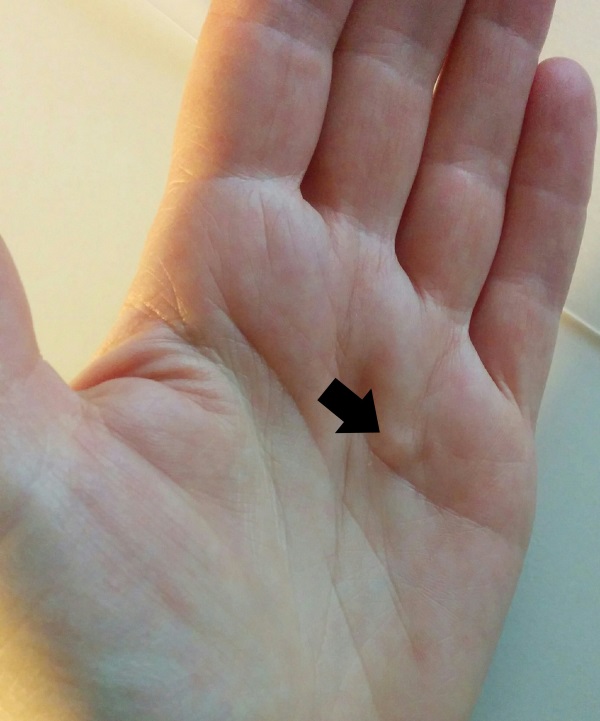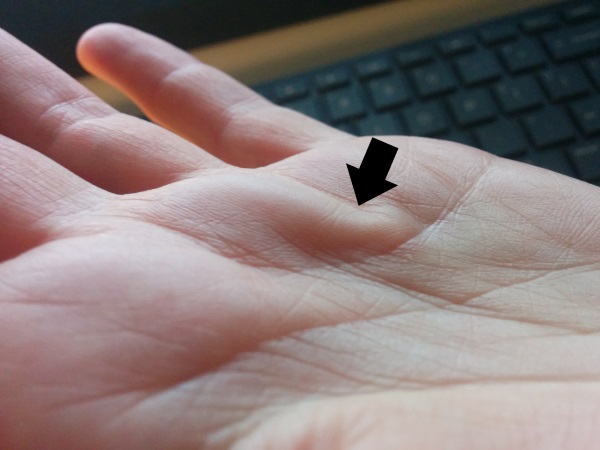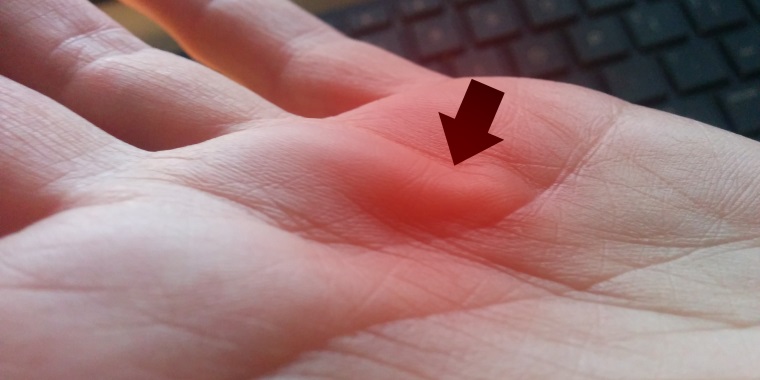I have Dupuytren’s Disease. Your Posture Doctor’s body is far from perfect. I wanted to share my diagnosis because many of you have journeyed with me since I left private practice to take my posture tips online, full-time.
About three months ago, I discovered a small lump in the palm of my hand. Having had a similar lump in my plantar fascia a year ago, I assumed my overly tight tendons have some calcific build-up.
Free Posture Crash Course!
Discover the crazy, simple 3-step formula that will teach you how to improve your posture and flexibility like a pro. You will learn how to hardwire the habit of good posture, reduce forward head and the secret way to stop slouching. It's 100% free!

I’ve also got a bunion on my right big toe – maybe you’ve seen my bunion mobilization videos – and an anatomical short leg that gives me functional scoliosis. I also have a video explaining the mechanism of short-leg scoliosis.
I’ve had chronic headaches since my early 20s, and I believe the underlying structural cause was initiated by an accident I had at age 9 when I was hit in the head with a wooden baseball bat, receiving eight stitches. Fortunately, my ongoing posture work keeps them at bay.
As a result of having an anatomically short right leg with scoliosis and being crazy active in sports up until university, I eventually had a disc herniation (slipped disc) while I was in practice as a chiropractor many years ago.
I FEEL YOUR PAIN!
When I tell you that I know what it is to have a problem posture and understand the frustration that regaining an attractive upright posture takes time – there is no quick-fix solution – I MEAN IT! I feel your pain.
The imperfections of my body are, in many ways, the bane of my life, and yet I know they are also my gifts. For if my body alignment and health were perfect, I most likely wouldn’t have become a Chiropractor or gone on to study the physics of posture.
It has become my absolute mission to correct my own posture, and along the way, I’m continually reminded of my student’s struggles and humbled by my own.
Dupuytren’s Disease
Dupuytren’s Disease is a disease of collagen tissue dysfunction. It is genetic. My grandfather had it. My grandfather was a supreme court judge in Canada. I am certain he was the man, the word gentleman was modeled after. In fact, we called him Grandfather as children. He even wore a dress shirt on our picnics and enjoyed smoking his pipe as we played in the sand.
Apparently, as a child, I used to hold my hands with my fingers bent, just like his were. He had Dupuytren’s contractures on both hands. I was not particularly eager to hold his hand crossing the street because his bent fingers felt funny to me.
Last night I Googled, ‘nodule in the flexor tendons of the hand,‘ and Dupuytren’s Nodule popped up. I don’t know why I hadn’t immediately clued in, but I hadn’t.
There isn’t a lot known about Dupuytren’s Disease. The treatment options are minimal and invasive:
Treating the symptoms or cause?
Just like posture, you can treat the symptoms (forward head posture, for example, with a chin tuck) or the cause (the structural alignment in the neck – after an x-ray diagnosis).
Oddly, Dupuytren’s Disease doesn’t really worry me. Do I need my hands?! Obviously, yes, I’m extremely active and write a lot. I could have an injection and watch the early sign (nodule) perhaps disappear. I know, however, that this approach fails to address the cause of Dupuytren’s. The problem is collagen. I am very interested in the WHY. Why is my collagen running amok?
WHY IS YOUR POSTURE THE WAY THAT IT IS?
Do you want to use a quick-fix youtube video exercise? I have plenty of those posture videos for you online. Or, do you want to address the underlying cause of your posture issues, and jump on board for the long run, and correct your posture for good?
Magnesium and Dupuytren’s Disease
I did some more research. This time I Googled, ‘Dupuytrens Nodules nutrition.’ I found Magnesium and Dupuytren’s Disease.
The article explained that my mother was a gene carrier for Dupuytren’s (thanks, mum), but more interesting to me was that some people had responded to topical Magnesium treatment. However, I realize that topical is still a symptom-based approach. I read on …
How does magnesium help?
The article explains that in Dupuytren’s Disease, collagen cells shrink or contract and that calcium is needed to allow this to happen.
The cell’s pulling mechanism requires calcium. In theory, magnesium might block the cells from pulling on the tissues by reducing the effect of calcium … magnesium might make the cells relax and allow a finger to loosen.
My next step …
Get magnesium levels tested! I’m going for a lab test tomorrow.
Laser for Dupuytren’s Disease?
The next thought that I had was recalling my mother’s success with laser for her Plantar Fasciitis. I next Googled, ‘laser for Dupuytren’s.’ This is what I found:
A Toronto Chiropractor had some success using Low-level laser therapy and Graston Technique. The theory goes that laser stimulates tissue repair and promotes proper soft tissue alignment as it heals. This is controversial, but it’s got to be better than cortisone injections, which can degrade and further damage tissues over time.
Pairing the physical tissue breakdown of laser with the myofascial release used in the Graston Technique makes sense to me!
What is Graston Technique?
Graston Technique is a patented form of manual therapy that uses stainless steel tools to perform tissue mobilizations. It is a kind of soft tissue mobilization used mainly by manual practitioners – Chiropractors, Osteopaths, Physical Therapists, etc.
What am I going to do about my Dupuytren’s Disease?
I’m going to take action. Many of you, reading this post, have followed me for several years – Read my posts, watching my videos, and maybe even tried some of my exercises. But how many of you have committed fully to your posture correction and long-term health?
What is the difference between those of us who dabble and those who really create change in our lives?
It’s simple, but it’s not necessarily easy …
ACTION
Dupuytren’s Disease action plan
Done! Do I feel worried about my Dupuytren? Not really. Taking action gives me freedom from worry. When I am proactive about my health, I know I am doing everything I can to have the best healthy future possible.

I want to be skiing at 80, not checking into a nursing home.
What about you? Are you a victim of your circumstance or the doctor of your destiny … I hope the latter.
Dupuytren’s Nodules: Natural Remedies
Dupuytren’s Nodules, also known as palmar fibromatosis, are a condition that affects the hand and fingers. This disorder can cause nodules to appear in the palm of the hand and contracture of the fingers which limits movement.
While there is no cure for this chronic condition, sufferers may be able to find relief through natural remedies.
Dupuytren’s Nodules are incredibly common among adults over 40 years old. According to research from 2016, an estimated 10 million Americans suffer from this painful disorder. The good news is there have been reports of people finding relief with alternative treatments such as massage therapy or lifestyle changes like stress management techniques.
Definition
Dupuytren’s nodules are like a tightening fist of the hand, slowly and steadily squeezing inwards. They form as small lumps on the palm or fingers that cause thickened skin, contractures, and inability to move one’s digits. This condition is caused by an accumulation of collagen fibers beneath the skin which causes it to stiffen and thicken over time. It can be quite painful at times, leaving patients frustrated with their lack of mobility.
Fortunately, there are natural remedies available for those suffering from Dupuytren’s nodules so they don’t have to live with this difficult condition any longer.
For centuries, people have used natural remedies such as herbs and oils to treat various ailments. For individuals experiencing Dupuytren’s nodules, these treatments may help reduce symptoms such as pain and stiffness while also improving flexibility.
Herbal supplements containing ingredients such as turmeric or ginger root extract can provide anti-inflammatory benefits that may help relieve swelling associated with Dupuytren’s nodules.
Additionally, massaging affected areas regularly using essential oils such as lavender oil or bergamot oil might improve circulation in that area and loosen up tight muscles for an increased range of motion.
While none of these methods will cure Dupuytren’s nodules completely, they offer some relief from its unpleasant symptoms so sufferers can enjoy life again without being held back by this debilitating condition.
Overview Of Symptoms
Dupuytren’s nodules are a type of benign lump found in the hands. They can cause discomfort and affect hand function, making everyday tasks difficult to perform. It is important to be aware of the symptoms associated with these nodules as they may indicate that medical treatment is necessary.
The most common symptom of Dupuytren’s nodules is visible, hard lumps on the palm or fingers. Other signs include tenderness, tightness or contracture of the skin around the area where the bumps are located, as well as decreased mobility in certain parts of the hand due to fibrosis (scarring).
In some cases, there may also be numbness or tingling sensations in affected areas. If any of these symptoms occur suddenly or progress quickly it is recommended that you seek medical advice from your doctor who will determine if further investigation and/or treatment is needed.
Early recognition and intervention are essential for maintaining a full range of motion and quality of life when dealing with this condition. Treatment options vary depending on severity; however natural remedies such as massage therapy and creams containing herbal ingredients have been used successfully by many people to reduce pain and improve flexibility.
Common Risk Factors
The risk factors associated with Dupuytren’s nodules are as diverse and varied as the symptoms they can cause. The good news is that by understanding what may increase your risks of developing them, you can take steps to minimize their impact on your life.
In general, people aged 40-70 are most at risk for developing Dupuytren’s nodules due to age-related changes in skin elasticity. Additionally, there are several other known risk factors which include but are not limited to:
- A family history of Dupuytren’s nodules
- Excessive alcohol consumption
- Diabetes mellitus or metabolic syndrome
- Smoking cigarettes or using tobacco products over long periods of time
- Certain prescription medications such as phenytoin or cyclosporine
It is important to note that these conditions do not necessarily guarantee the development of Dupuytren’s nodules; however, having any one (or more) of these predisposing factors increases the likelihood of occurrence.
Therefore it is advised that those who possess any of these risk factors should be extra vigilant in monitoring their hands for signs and symptoms related to this condition. Prevention through early intervention remains an essential part of treating this disorder effectively.
Diagnostic Tests
When diagnosing Dupuytren’s nodules, a physical examination is typically the first step. The doctor will examine your hands and fingers to determine if you have a nodule or even multiple nodules present. In some cases, an X-ray may be recommended to evaluate the size of the lesion and its depth within the tissue. An ultrasound can also help in determining whether there are additional lesions that cannot be seen on the surface.
If further evaluation is needed, MRI or computed tomography (CT) scans may be used to assess any associated ligament damage as well as to see how far down into the hand the disease has progressed.
Blood tests can also provide insight as to potential causes of this condition such as diabetes, thyroid problems, and other systemic diseases that could increase your risk for developing these lesions.
All of these diagnostic tools can help your physician make an accurate diagnosis so they can recommend appropriate treatment options.
Exercise Therapy
Exercise therapy is considered to be a viable, natural remedy for those suffering from Dupuytren’s nodules. Exercise can help reduce the tension in your hands and fingers that cause or exacerbate these lesions. Exercises such as stretching, range of motion exercises, and strengthening exercises have all been found to be useful for relieving symptoms associated with Dupuytren’s nodules.
Stretching involves gently moving the affected area in different directions so as to increase flexibility and range of motion. Range of motion exercises focuses on improving movement within the joint while strengthening exercises are designed to strengthen weakened muscles and improve circulation.
Splinting And Casting
Moving on from exercise therapy, splinting and casting are two additional treatments that may be beneficial for those with Dupuytren’s nodules. Splinting can help to reduce the pain associated with contractures in this condition, as well as maintain a certain degree of mobility in the affected area.
It involves wearing a brace or device that is custom-fitted to immobilize the joint while allowing some range of motion. This type of treatment should only be done under the guidance of a physician and requires frequent adjustments based on the patient’s individual needs.
Casting may also provide relief from symptoms caused by Dupuytren’s nodules, such as pain and immobility. The cast material is customized to fit around the affected hand, wrist, or finger depending on where it is located.
Casting helps to stabilize joints and decrease any movement that could cause further damage due to inflammation or scarring. Casts must be changed regularly since they will eventually become loose over time due to natural wear and tear. Patients should receive instructions from their doctor regarding how often casts need to be replaced so that proper care can be taken when changing them out at home.
It is important for patients suffering from Dupuytren’s nodules to understand all available treatment options before making any decisions about what course of action would work best for them. Splinting and casting can both offer effective solutions but ultimately each person must determine which approach works best for his or her own unique situation.
Non-Surgical Treatments
When it comes to treating Dupuytren’s nodules, there is a range of non-surgical treatments available. While these may not be as effective as surgical procedures, they offer some relief and can help manage the condition. It is important for those with Dupuytren’s to understand their options in order to make an informed decision about which treatment plan best suits them.
Traditional therapies such as stretching exercises, splinting, massage therapy, and physical therapy have been used successfully in many people with Dupuytren’s nodules. These techniques can reduce pain associated with the disorder and increase joint mobility by helping loosen contracted tissue over time.
Additionally, injections of various medications — such as corticosteroids or collagenase clostridium histolyticum (CCH) — into the nodules themselves can also provide temporary relief from symptoms and softening of hardened tissue.
For those who prefer natural remedies, topical products containing herbs like turmeric and nutmeg oil may also help improve circulation and flexibility in affected areas.
Topical Creams And Ointments
In addition to non-surgical treatments, topical creams and ointments are other options for treating Dupuytren’s nodules. These medications can reduce the size of any existing nodules as well as prevent new ones from forming. They have proved effective in many cases with minimal side effects, making them an attractive choice for those hoping to avoid surgery.
Other options include retinol creams and silicone gel sheets, which may help improve skin elasticity and reduce discomfort caused by contact between fingers or hand surfaces.
Additionally, some plant extracts such as aloe vera, chamomile, green tea, and turmeric could potentially provide relief from symptoms of Dupuytren’s nodules when applied topically. However, more research is needed to understand their efficacy in this area.
Home Remedies And Herbal Supplements
Dupuytren’s nodules can be like a stubborn weed, difficult to eradicate. Fortunately, there are natural remedies available that may help reduce the severity of symptoms and improve mobility. Home remedies typically involve stretching exercises, as well as physical therapy techniques such as massage or heat application.
These therapies have been shown to help relax the muscles in the affected area and prevent contractures from developing further. Additionally, herbal supplements may also be beneficial for relieving inflammation and pain associated with Dupuytren’s nodules.
In addition to home remedies and herbal supplements, patients should also seek professional medical advice to discuss potential surgical options if their condition persists over time without improvement. Surgery is often an effective solution for treating more severe cases of Dupuytren’s disease but should only be considered after other conservative measures have failed.
Acupuncture
Acupuncture is an increasingly popular alternative therapy for the treatment of Dupuytren’s nodules. It involves inserting fine needles into specific points on the body to stimulate energy flow and encourage healing.
This ancient Chinese practice has been shown to reduce inflammation, improve circulation and promote relaxation. There is also evidence that it can help reduce pain associated with the condition. In addition, acupuncture can be used alongside traditional medical treatments such as surgery or steroid injections.
Research suggests that acupuncture may be beneficial in treating Dupuytren’s nodules by reducing symptoms such as tenderness, swelling and decreased mobility.
Acupuncturists typically use a combination of stimulation techniques including needling, moxibustion, cupping and electrical stimulation depending on what works best for the individual patient. While more research needs to be conducted before definitive conclusions about the effectiveness of acupuncture for Dupuytren’s nodules can be made, many patients report positive results after undergoing this type of treatment.
Massage Therapy
Massage therapy could be a beneficial treatment for those suffering from Dupuytren’s nodules. It is generally recommended to begin massage treatments as soon as possible after being diagnosed with the condition which can help reduce pain and improve mobility within the affected area.
Massage therapists may use various techniques such as kneading, tapping, rubbing, and stretching in order to help relax muscles around the nodule and reduce inflammation of the surrounding tissues. As if unlocking a locked door, massage helps break up adhesions that form between layers of tissue near the nodule, resulting in improved blood flow and reduced muscle tension.
In addition to improving physical function, massage therapy has been found to provide mental relief by reducing stress levels associated with this condition. Studies have shown that regular massages can increase positive emotions while decreasing negative thoughts about one’s health or body image.
As an overall result, massage therapy can offer comfort and increased quality of life for those living with Dupuytren’s nodules.
Soaring above common treatments like surgery or steroids, it provides a safe option for sufferers who are looking for natural remedies to manage their symptoms more effectively.
Nutrition And Dietary Changes
Moving on from massage therapy, nutrition and dietary changes can also be employed as a natural remedy for Dupuytren’s nodules.
Generally speaking, it is advisable to eat an anti-inflammatory diet that consists of fresh fruits and vegetables, whole grains, lean proteins, healthy fats, nuts and seeds.
This type of diet helps reduce inflammation in the body which can help slow down the progression of Dupuytren’s nodules. It is important to ensure adequate intake of vitamin C and zinc; Vitamin C has been found to play a role in collagen synthesis while zinc has been shown to have anti-inflammatory properties.
Additionally, eating foods high in antioxidants such as berries and dark leafy greens may be beneficial in combating oxidative stress caused by Dupuytren’s contracture. Furthermore, reducing or eliminating processed foods and refined carbohydrates may help decrease symptoms associated with this condition.
It is recommended to consult a registered dietitian or nutritionist who specializes in chronic illnesses like Dupuytren’s contracture before making any major changes to one’s diet.
Prognosis And Outcome
What impact do Dupuytren’s nodules have on long-term prognosis?
Generally, the course of a Dupuytren’s nodule is unpredictable. While most cases are mild, some individuals may experience recurrence or progression over time.
The outcome for individuals with individual Dupuytren’s nodules can vary depending upon their age and medical history — as well as other factors such as lifestyle and genetics. In general, patients who are younger and have no underlying medical conditions tend to show better outcomes overall than those who are older or have pre-existing health issues.
| Age Group | Recurrence Rate | Progression Rate |
|---|---|---|
| Under 30 Years Old | 10% | 15% |
| 30 – 50 Years Old | 20% | 25% |
| 50+ Years Old | 40% | 35% |
As shown in the table above, the likelihood of both recurrence and progression increases significantly with age. For example, an individual under the age of thirty has a ten percent chance of experiencing recurrent Dupuytren’s Nodules while someone fifty years old could expect up to forty percent recurrence rate. Additionally, individuals aged fifty-plus will likely see more instances of disease progression compared to those younger than that threshold.
It is important to note that certain lifestyle changes such as smoking cessation or obesity reduction may help reduce the occurrence or severity of symptoms associated with Dupuytren’s nodules.
Similarly, surgical intervention should be considered if symptoms become severe enough to interfere with daily activities like gripping objects or walking comfortably.
Coping Strategies
Dupuytren’s nodules can be a difficult condition to manage, but it is important for the patient to take proactive steps in order to cope. The first step is to seek medical advice and create an individual treatment plan with your doctor or specialist.
This should include lifestyle changes such as avoiding certain activities that could aggravate the nodules further, like heavy lifting or excessive gripping. It may also include modifications such as using padding on surfaces you frequently touch so they are more comfortable when you press against them.
You may find relief through home remedies as well, including topical ointments containing natural ingredients such as vitamin E oil or aloe vera gel. Massage therapy and physical exercise can also help improve circulation and flexibility in the affected area.
Herbal supplements have been found to reduce inflammation and pain associated with Dupuytren’s nodules too; however, always consult your physician before taking any kind of supplement or medication. With proper management and care, coping with Dupuytren’s nodules is possible.
Prevention Techniques
The key to preventing Dupuytren’s nodules is understanding what triggers them. As the old adage says, “An ounce of prevention is worth a pound of cure.” There are several holistic techniques that may help reduce the risk or severity of developing this condition.
First and foremost, it is important to maintain good overall health with proper diet and exercise. Eating anti-inflammatory foods such as fatty fish, fruits, vegetables, and nuts can reduce inflammation throughout the body – including any underlying causes of Dupuytren’s nodules. Regular physical activity strengthens muscles and tendons which helps keep hands limber and flexible. Additionally, reducing stress levels by practicing relaxation exercises like yoga or tai chi can be beneficial in both preventing new nodules from forming as well as aiding existing ones on their healing journey.
Finally, when performing activities that require frequent use of the hands (e.g., gardening or playing a musical instrument) it is best to take periodic breaks for rest so that tension does not build up over time in one area of your hand. Wearing protective gloves during labor-intensive tasks will also provide extra cushioning against potential strain or trauma which could cause Dupuytren’s nodules to form more easily. By following these basic steps you can make sure your hands stay healthy while avoiding unnecessary discomfort caused by this condition!





8 thoughts on “Dupuytren’s Nodules: Natural Remedies”
Hi Paula,
Thanks for that very interesting read. I like your approach. I hope that you are successful. I had always thought that chiropractors, sort of, had perfect bodies. So, a revelation.
You successfully treated me on 26/10/10 at Lushington Chiropractic in Eastbourne, and I remember that so well. I am still a regular there.
Best wishes and good luck,
Chris Marlow
Hello Chris!
Lovely to hear from you.
Funny isn’t it, how humbling it can be to find out the very people we learn from, are just as ‘imperfect’ as we are.
Stay in touch 🙂
Paula
Wonderful Posture Doc,
I’ve made changes in my posture, and in my thinking (underlying cause/motivation) through these years of watching your videos! From Hawaii to Paris to Ireland I’ve often kept the exercise pics on my open desktop even when not using it, just to inspire me!
The other day here in Hawaii I pulled up a newer video of you, using a pic of the chin-tuck guy from long ago…you were seated and looked well, as if you had been sad-heartened, not like the same energizing gal. You seemed soul-saddened. My own heart felt empathy and I started praying to Almighty God to heal you and touch you. You have brought much joy and healthful techniques into my life. In fact I was teaching a 78 year old neighbor about chin tucks this very week.
You take care my dear, and know you are loved and appreciated with special prayers going up.
Aloha, bonjour and all the best,
your student of years,
Christina
Hello Christina,
How wonderful my videos have been with you all these years. Smiles from Canada 🙂
I’m happy and well; thank you for your thoughts and prayers – can never have too many of those!
Paula
Hello,
I just happened upon your blog post while researching treatments for Duypuytren’s. I am curious to know if you had gone forward and had Graston and laser done to your hand and if it has had any effect. I am a nurse practitioner and last week a gentleman consulted with me to see what I could do for him. He had already seen an ortho who told him he would inject the collagenase enzyme solution once the contracture worsened. This patient cannot afford the exorbitant cost. The office where I work provides chiropractic treatment and one of my thoughts was Graston Technique. There is really no research on this with Duypuytren’s so I would love to know if you have tried this and how it has worked for you.
Hi Kris,
Duypuytren’s is a curious diagnosis indeed. I wouldn’t worry too much about anecdotal evidence, as it seems the ‘disease’ is so poorly researched and understood in general.
I haven’t had the laser done but I’ve been working away at the nodule in a Graston-type approach and I think I’m pretty happy with the results thus far: No progression and some decrease in size. Might be worth trying – at worst, there is no difference, at best a resolution!
Here is a picture I took just now, sitting here typing my response to you: https://bit.ly/2CF9TwM
Thank you for your comment,
Dr Paula
Dr. Paula,
Thank you for your reply and I’m happy to hear this has had some positive effect for you. I discussed this case with one of our doctors, who is skilled in Graston Technique, and he is willing to try it on this patient. Our practice also has a cold laser so this may be added on as well. This patient’s contracture is much more advanced than yours. His 5th digit is flexed to about 45 degrees at the PIP joint. He may need surgery at some point, but I too believe this would be worth a try.
Regards,
Kris
Wow, I’d love to see your progress. Please take before and after pics and share progress as and when.
Best in posture,
Dr Paula